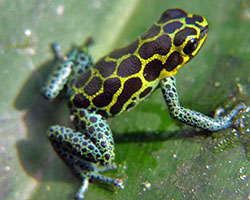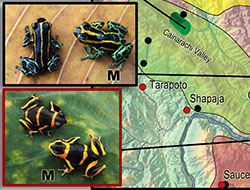
Colorful Copycat Frogs of Peru
What's in the Story?
Juan lived in a small town surrounded by rainforest in the mountains of Peru. One of his favorite animals was the splash-back poison frog. Juan learned to recognize this frog's brilliant colors and other colorful poison frogs near his home.
One day he noticed something strange – he heard two male frogs singing near each other. They both looked like the splash-back poison frog, but they had completely different songs. Juan also noticed different colored eggs in the territories of each male. One male was guarding white eggs. The other male was guarding black eggs. Different songs and egg colors helped Juan realize that these two different frogs, which looked the same, were actually different species!

Usually when we think of members of a single species, we think they will look similar to each other and different from other species. But sometimes this isn't true. Mimic poison frogs can look different, depending on what other frog species they are mimicking. In the PLOS ONE article “Phenotypic and Genetic Divergence among Poison Frog Populations in a Mimetic Radiation,” scientists investigated how a poisonous frog from the Amazon rainforest in Peru uses this mimicry to avoid being attacked by predators.
Hiding in Plain Sight
The Amazon rainforest is a beautiful place, but it is also a giant snack bar for predators. And what’s on the menu depends on how big you are. Smaller animals tend to find themselves on the menu of many larger animals. Because of this, many small animals will try to hide by blending in with their surroundings. If a larger animal can’t find them, they can avoid being eaten.

Other animals take a different approach. Rather than sneaking around, they will strut their stuff by sporting bright colors and/or bold patterns. It is as if they are trying to say “eat me if you dare!”
So what’s special about these animals that lets them avoid being eaten even though they stand out? As it turns out, the bright colors are meant to warn other animals to avoid eating them because they taste very bad or are poisonous. Warning coloration tells other animals that if they try to taste the poisonous animal, they will regret it.
Many different animals have this kind of coloration, from butterflies to tropical frogs. The poison frogs of South and Central America, known as dendrobatid frogs, are a great example of this. They have poisons in their skin, and their brightly colored bodies warn potential predators to back off.
Different Strokes for Different Folks
In Peru, scientists working on populations of poison frogs called Ranitomeya imitator noticed that the frogs looked different in different places. Using some detailed measurements of color and pattern, they found that the colors and patterns of different populations of frogs were unique.

They showed that this was the case even from a “bird’s eye view.” They used special methods to look at the frogs through the eyes of birds, and showed that they still looked very different from one another. Birds are one of the main predators on little frogs on the forest floor, so it is important to understand what the frogs look like from this perspective.
Overall, scientists found that the frogs looked different in each place they studied. But they also noticed that the frogs in each place resembled other species living in that area. Frog populations in each place might have evolved differences in color pattern that match the other local species. This is known as Müllerian mimicry, named after Fritz Müller, who came up with the idea way back in the 1800s.
Taste Testing
Predators don’t always know right away what these bright colors mean. It turns out that they have to learn what is good to eat and what isn’t. They do this by trial and error. If they get a mouthful of poison from a bright red animal, they learn not to eat any animal with a similar color. But they still might try to eat animals with different colors.
If a frog has a pattern similar to another poisonous animal in its environment, it might be less likely to be tasted by predators. After a predator learns the colors of one bad-tasting animal, it's likely to assume other animals with similar colors also taste bad. Because of this, the predator would likely avoid both animals altogether.

To study whether frogs were relying on this Müllerian mimicry, scientists looked at the color patterns of frogs through the eyes of their predators. Using their "bird's eye view" method, they showed that the colors of the model (the animal the frogs wanted to look like) and mimic (the mimic poison frog itself) were more similar to each other than they were to those of the other populations of mimic poison frog. This meant that each population of the mimic frogs looked more like the local model species than like the other color pattern types of their own species.
Scientists also looked at the genes of the different colored populations of frogs. They found that these different frog populations were very closely related even though they looked very different. They also found some places where mimic frogs with different color pattern types were breeding together, making offspring that looked like a mix of each type.
So, why study this puzzle of patterns in poison frogs? These small frogs can quickly evolve new colors and patterns to look like their neighbors because it helps them avoid becoming lunch. Now that scientist know that species' color patterns can change quickly in different populations, they are trying to figure out how this process works. In particular, they are finding out which genes control these differences in color pattern, and how they can evolve so quickly.
Additional images via Wikimedia Commons.
Bibliographic details:
- Article: Colorful Copycat Frogs of Peru
- Author(s): Kyle Summers
- Publisher: Arizona State University School of Life Sciences Ask A Biologist
- Site name: ASU - Ask A Biologist
- Date published:
- Date accessed:
- Link: https://askabiologist.asu.edu/plosable/colorful-copycats
APA Style
Kyle Summers. (). Colorful Copycat Frogs of Peru. ASU - Ask A Biologist. Retrieved from https://askabiologist.asu.edu/plosable/colorful-copycats
Chicago Manual of Style
Kyle Summers. "Colorful Copycat Frogs of Peru". ASU - Ask A Biologist. . https://askabiologist.asu.edu/plosable/colorful-copycats
Kyle Summers. "Colorful Copycat Frogs of Peru". ASU - Ask A Biologist. . ASU - Ask A Biologist, Web. https://askabiologist.asu.edu/plosable/colorful-copycats
MLA 2017 Style

Be Part of
Ask A Biologist
By volunteering, or simply sending us feedback on the site. Scientists, teachers, writers, illustrators, and translators are all important to the program. If you are interested in helping with the website we have a Volunteers page to get the process started.

